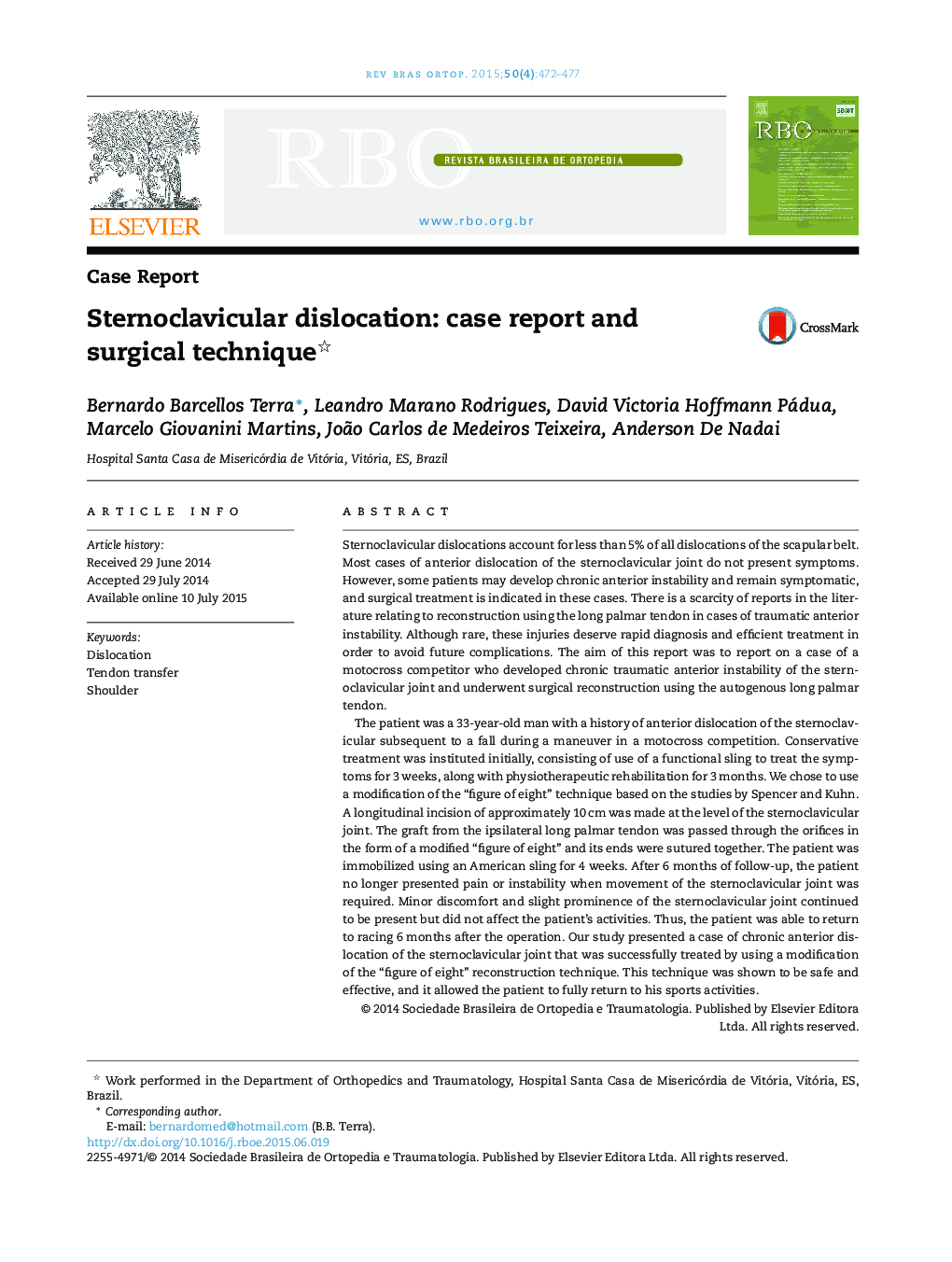| Article ID | Journal | Published Year | Pages | File Type |
|---|---|---|---|---|
| 2708018 | Revista Brasileira de Ortopedia (English Edition) | 2015 | 6 Pages |
Sternoclavicular dislocations account for less than 5% of all dislocations of the scapular belt. Most cases of anterior dislocation of the sternoclavicular joint do not present symptoms. However, some patients may develop chronic anterior instability and remain symptomatic, and surgical treatment is indicated in these cases. There is a scarcity of reports in the literature relating to reconstruction using the long palmar tendon in cases of traumatic anterior instability. Although rare, these injuries deserve rapid diagnosis and efficient treatment in order to avoid future complications. The aim of this report was to report on a case of a motocross competitor who developed chronic traumatic anterior instability of the sternoclavicular joint and underwent surgical reconstruction using the autogenous long palmar tendon.The patient was a 33-year-old man with a history of anterior dislocation of the sternoclavicular subsequent to a fall during a maneuver in a motocross competition. Conservative treatment was instituted initially, consisting of use of a functional sling to treat the symptoms for 3 weeks, along with physiotherapeutic rehabilitation for 3 months. We chose to use a modification of the “figure of eight” technique based on the studies by Spencer and Kuhn. A longitudinal incision of approximately 10 cm was made at the level of the sternoclavicular joint. The graft from the ipsilateral long palmar tendon was passed through the orifices in the form of a modified “figure of eight” and its ends were sutured together. The patient was immobilized using an American sling for 4 weeks. After 6 months of follow-up, the patient no longer presented pain or instability when movement of the sternoclavicular joint was required. Minor discomfort and slight prominence of the sternoclavicular joint continued to be present but did not affect the patient's activities. Thus, the patient was able to return to racing 6 months after the operation. Our study presented a case of chronic anterior dislocation of the sternoclavicular joint that was successfully treated by using a modification of the “figure of eight” reconstruction technique. This technique was shown to be safe and effective, and it allowed the patient to fully return to his sports activities.
ResumoAs luxações esternoclaviculares representam menos de 5% de todas as luxações da cintura escapular. A maioria dos casos de luxação anterior da articulação esternoclavicular não apresenta sintomas. Entretanto, alguns pacientes podem desenvolver instabilidade anterior crônica e permanecer sintomáticos. Nesses casos é indicado o tratamento cirúrgico. A literatura é escassa em relação à reconstrução com uso do tendão palmar longo nos casos de instabilidade anterior traumática. Embora raras, essas lesões merecem diagnóstico rápido e tratamento eficaz para evitar complicações futuras. O objetivo deste trabalho foi relatar um caso de um atleta de motocross que evoluiu com instabilidade anterior traumática crônica da articulação esternoclavicular e foi submetido a reconstrução cirúrgica com o uso do tendão palmar longo autógeno.Paciente masculino, 33 anos, com história de luxação anterior da articulação esternoclavicular após queda durante manobra em um campeonato de motocross. Inicialmente foi empregado o tratamento conservador, com uso de tipoia funcional por três semanas, e sintomático, além da reabilitação com fisioterapia por três meses. Optamos por usar uma modificação da técnica do “oito”, baseados nos estudos de Spencer e Kuhn. A incisão longitudinal de aproximadamente 10 cm foi feita no nível da articulação esternoclavicular. O enxerto do tendão palmar longo ipsilateral foi passado pelos orifícios em forma de “oito” modificado e suas extremidades foram suturadas conjuntamente. O paciente foi imobilizado com tipoia americana por quatro semanas. No fim de seis meses de seguimento não apresentava dor ou instabilidade quando solicitada a articulação esternoclavicular. Um discreto desconforto e ligeira saliência da articulação esternoclavicular permaneceu, mas não afetaram suas atividades, o que permitiu ao paciente voltar às pistas de corrida com seis meses de pós-operatório. Nosso estudo apresentou um caso de luxação anterior crônica da articulação esternoclavicular tratado com sucesso com o uso de uma modificação da técnica de reconstrução em “oito”. Essa técnica mostrou ser segura e eficaz e permitiu um retorno total às atividades esportivas do paciente.
